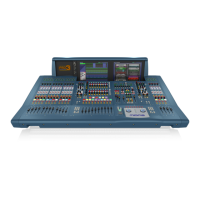PRO Series output channel EQ modes 347
PRO Series Live Audio Systems
Operator Manual
PRO Series output channel EQ modes
This section aims to provide an understanding of the output channel EQ modes
contained within the PRO Series Control Centre.
Basic specification
The PRO Series output EQ comprises six bands strategically positioned at certain
frequencies ranging from the low end (bass) to the high (treble) of the frequency band.
The default operation for all six sections is full parametric sweep (peak), with the
following controls:
• Gain: continuous adjustment of boost and cut from + 16dB to -16dB, with a 0dB
centre detent.
• Width: continuous adjustment of bandwidth from 0.1 to 3.0 octaves.
• Frequency: continuous adjustment of the frequency range that the band EQ acts on
from 16Hz to 25kHz.
Band 1 can be switched from bell to any of three shelving modes:
•Warm
• High pass filter 6dB
• High pass filter 12dB
Band 2 can be switched from bell to high pass filter 24dB shelving mode.
Band 6 can be switched from bell to any of three shelving modes:
•Soft
• Lo pass filter 6dB
• Lo pass filter 12dB
Description of the output channel EQ modes
Soft (treble)
The soft treble response provides a very gentle gradient between EQ’d and non-EQ’d
frequency areas. This produces the absolute minimum of phase shift, but does not
provide much differentiation, thus frequencies outside the area of interest are often
unintentionally EQ’d. This is best used to provide gentle shaping of pre-mixed material.
Warm (bass)
The warm bass response provides a very gentle gradient between EQ’d and non-EQ’d
frequency areas. This produces the absolute minimum of phase shift, but does not
provide much differentiation, thus frequencies outside the area of interest are often
unintentionally EQ’d. This is best used to provide gentle shaping of pre-mixed material.
High pass filter (HPF)
The HPF attenuates (not boosts) all frequencies below a certain level (cut-off
frequency) while allowing all those above it to pass through. The harshness or
smoothness with which the sound is removed beyond this point is determined by the
dB/octave, with 6dB being the most common. The HPF is generally used to take rumble
or hum out of any sound source, but may also produce a sound effect by manipulation
of the controls.
The high pass filters of the PRO Series have gain roll off before the corner frequency,
which is variable.

